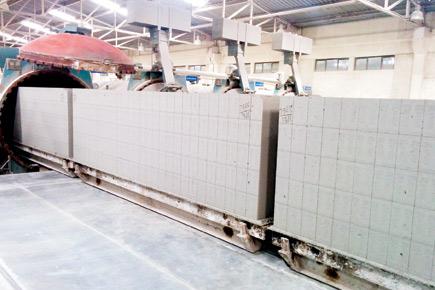MHADA officials and contractors quote IIT study to claim the prefabricated material they use to construct homes don't just make it cost-effective, but also sturdy enough to survive earthquakes

Prefab is a mixture of cement and fly ash and is used in larger sizes as blocks to construct beams, columns, floor and walls
Why are homes constructed by the State government’s housing agencies cheaper than those built by private developers? The main reason, say experts, is because homes constructed by Maharashtra Housing and Area Developing Authority (MHADA) are made of prefabricated material that is nearly 15 per cent cheaper than the bricks used by private developers to build houses.
ADVERTISEMENT

Prefab is a mixture of cement and fly ash and is used in larger sizes as blocks to construct beams, columns, floor and walls
But this does not make MHADA homes any less sturdy. In fact, most homes built by the housing authority are equipped to withstand major earthquakes like the one that had rocked Gujarat over a decade ago. According to experts, while building an apartment, the conventional way costs around R2,000 per square foot, buildings that use the prefab method costs around Rs 1750-1800 per square foot.
Prefab is basically a mixture of cement and fly ash. It is used in larger sizes as blocks to construct beams, columns, floor, walls and even staircases of the building. MHADA uses the same technique to construct buildings in Mumbai and other areas.
A senior officer from Shirke Constructions, the contractor appointed by MHADA, said, “Our homes have been tested by IIT engineers and they have certified that these buildings can withstand an earthquake.”
Another officer from the company said, “We have been using prefab technology to construct MHADA homes in Mumbai for quite some years now. This technology is lightweight and also cheaper than the conventional method of using bricks. It also enables us to finish our projects faster and at a lower cost than most privately-built homes.”
Not that great?
However, while the sturdiness and affordability of the prefab technology maybe beyond doubt, some experts argue that at the end of the day, a majority of MHADA homes are not really well built and that most residents complain of leaky ceilings and crumbling walls within months. Answering these charges, a senior MHADA official said, “It’s not due to bad construction. Residents carry out alteration in homes, thus damaging the basic structure.”
 Subscribe today by clicking the link and stay updated with the latest news!" Click here!
Subscribe today by clicking the link and stay updated with the latest news!" Click here!






